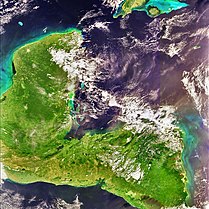Our website is made possible by displaying online advertisements to our visitors.
Please consider supporting us by disabling your ad blocker.
Central America
 | |
| Area | 523,780 km2 (202,230 sq mi)[1] |
|---|---|
| Population | 52,700,000 (2023)[1] |
| Population density | 100.6/km2 (260.6/sq mi) (2023) |
| GDP (PPP) | $738.8 billion (2023) |
| GDP (nominal) | $362.62 billion (exchange rate) (2023) |
| GDP per capita | $6,880 (exchange rate) (2023) $14,019 (PPP) (2023) |
| Demonym | Central American[a] |
| Countries | |
| Dependencies | |
| Languages | |
| Time zones | UTC−06:00 to UTC−05:00 |
| Largest cities | |
| UN M49 code | 013 – Central America419 – Latin America and the Caribbean019 – Americas001 – World |
| Part of a series on |
| Central America |
|---|
 |
Central America[b] is a subregion of North America.[2] Its political boundaries are defined as bordering Mexico to the north, Colombia to the southeast, the Caribbean to the east, and the Pacific Ocean to the southwest. Central America is usually defined as consisting of seven countries: Belize, Costa Rica, El Salvador, Guatemala, Honduras, Nicaragua, and Panama. Within Central America is the Mesoamerican biodiversity hotspot, which extends from southern Mexico to southeastern Panama. Due to the presence of several active geologic faults and the Central America Volcanic Arc, there is a high amount of seismic activity in the region, such as volcanic eruptions and earthquakes, which has resulted in death, injury, and property damage.
In the pre-Columbian era, Central America was inhabited by the Indigenous peoples of Mesoamerica to the north and west and the Isthmo-Colombian peoples to the south and east. Following the Spanish expedition of Christopher Columbus' voyages to the Americas, Spain began to colonize the Americas. From 1609 to 1821, the majority of Central American territories (except for what would become Belize and Panama, and including the modern Mexican state of Chiapas) were governed by the viceroyalty of New Spain from Mexico City as the Captaincy General of Guatemala. On 24 August 1821, Spanish Viceroy Juan de O'Donojú signed the Treaty of Córdoba, which established New Spain's independence from Spain.[3] On 15 September 1821, the Act of Independence of Central America was enacted to announce Central America's separation from the Spanish Empire and provide for the establishment of a new Central American state. Some of New Spain's provinces in the Central American region (i.e. what would become Guatemala, Honduras, El Salvador, Nicaragua and Costa Rica) were annexed to the First Mexican Empire; however in 1823 they seceded from Mexico to form the Federal Republic of Central America until 1838.[4]
In 1838, Costa Rica, Guatemala, Honduras, and Nicaragua became the first of Central America's seven states to become independent countries, followed by El Salvador in 1841, Panama in 1903, and Belize in 1981.[5] Despite the dissolution of the Federal Republic of Central America, countries like Costa Rica, El Salvador, Guatemala, Honduras, and Nicaragua continue to maintain a Central American identity.[6] Belizeans are usually identified as culturally Caribbean rather than Central American, while Panamanians identify themselves more broadly with their South American neighbors.[citation needed]
The Spanish-speaking countries officially include both North America and South America as a single continent, América, which is split into four subregions: North America (Northern America and Mexico), Central America, South America, and Insular America (the West Indies).[7]
- ^ a b "Central America Population". World Population Review. Retrieved 26 June 2022.
- ^ "Central America". central-america.org. Archived from the original on 11 September 2016. Retrieved 4 September 2016.
Central America is located between North and South America and consists of multiple countries. Central America is not a continent but a subcontinent since it lies within the continent America. It borders on the northwest to the Pacific Ocean and in the northeast to the Caribbean Sea. The countries that belong to the subcontinent of Central America are El Salvador, Costa Rica, Belize, Guatemala, Honduras, Nicaragua and Panama.
- ^ "Spain accepts Mexican independence". HISTORY. Retrieved 3 June 2019.
- ^ Ribeiro, Pedro Freire (1995). Raízes do pensamento político da América Espanhola, 1780–1826. Niterói, RJ: Editora da Universidade Federal Fluminense. ISBN 85-228-0146-0. OCLC 35578070.
- ^ "A Guide to the United States'History of Recognition, Diplomatic, and Consumer Relations, by Country, since 1776: Belize". Office of The Historian. Retrieved 17 February 2021.
- ^ Demographic Diversity and Change in the Central American Isthmus. Pebley, Anne R. and Luis Rosero-Bixby, eds., Santa Monica, CA: RAND Corporation, 1997. Also available in print form.
- ^ América Insular ¿Qué es? ¿Cómo se divide? ¿Qué países pertenecen? (in Spanish)
Cite error: There are <ref group=lower-alpha> tags or {{efn}} templates on this page, but the references will not show without a {{reflist|group=lower-alpha}} template or {{notelist}} template (see the help page).
Previous Page Next Page


